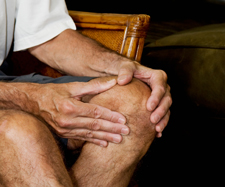Arthritis 101: the many faces of arthritis
While many of us think we know what arthritis is—that pain or stiffness you’ve heard others complain of or experienced yourself—the reality is that there are more than 100 forms of the disease.  And while each has its own identifying markers, they all share one common trait: a negative impact on the health and well-being of those who are affected. Read on to learn about the most common kinds of arthritis and warning signs.
And while each has its own identifying markers, they all share one common trait: a negative impact on the health and well-being of those who are affected. Read on to learn about the most common kinds of arthritis and warning signs.
Osteoarthritis
When most of us think of arthritis, it’s usually the "wear-and-tear" variety, or osteoarthritis (OA), that comes to mind. The most common form of the disease, OA affects one in 10 North Americans—often those over 45—and is caused by the erosion of the cartilage or "padding" which normally absorbs the impact or "shock" of regular movement. It’s not surprising then, that OA typically creeps into weight-bearing joints—including the hips, spine, knees and feet—over time, often starting as stiffness and developing to include pain and swelling in the affected area. While the cause is still uncertain, you’re more likely to develop osteoarthritis if you carry extra weight, have previously injured a joint that didn’t entirely heal or if there’s a history of OA in your family.
Rheumatoid arthritis
Unlike OA where the cartilage erodes, rheumatoid arthritis (RA) inflames healthy joints because the body’s immune system wrongly turns on itself and attacks. The swelling often spreads to the joints around the original site and usually ends up affecting five or more joints in the body—typically in the hands, knees, wrists, shoulders or ankles. Depending on the person, the symptoms and severity of RA can range from mild intermittent "flare ups," to more chronic and severe inflammation that can eventually impact blood vessels, skin and, in some cases, even lead to inflamed membranes around vital organs. It usually takes hold in adults between the ages of 30 and 60. One study of rheumatoid arthritis revealed that three quarters of all damage caused by the disease happens in the early years of onset, making the need for a quick diagnosis even more important.
Fibromyalgia
Although fibromyalgia is often considered an arthritis-related condition, it is not truly a form of arthritis. This is a syndrome that has worn many different labels—including soft tissue rheumatism and fibrositis—but awareness and understanding of fibromyalgia is on the rise. And it should be: it’s thought to affect between two and six per cent of the population (mostly women) between the ages of 30 and 50 years old. Impaired joints and soft tissue are primary symptoms. Poor sleep, chronic fatigue, trouble concentrating, irritable bowel syndrome, depression and mood disorders also go hand-in-hand with fibromyalgia, though it’s thought that many of these are caused by the effect the chronic pain has on the individual rather than the disease itself. Just as varied as the symptoms, are the proposed causes of fibromyalgia. Triggers such as joint issues with the back and neck, viruses, accidents and/or physical and emotional stress are all thought to be culprits.
Juvenile arthritis
Juvenile arthritis, though sometimes known as a form of rheumatoid arthritis, behaves quite differently from its adult counterpart. Striking one in 1,000 children, the disease causes the inflammation of one or several joints, over a longer period of time (six weeks or more). Juvenile arthritis can be difficult to diagnose as many kids don’t complain of inflammation or pain, stiffness, a limp or limited mobility which may all be signs of the disease. Juvenile arthritis ranges greatly in its symptoms, impact and duration. Kids may suffer an episode over a period of months and then the condition simply vanishes. Less fortunate young people, however, may grapple with flare-ups over years, sometimes disrupting growth and causing additional health problems.
While there is no cure for arthritis, early diagnosis is the best way to manage the condition and minimize the negative consequences it can have on you or a loved one’s life. If any of the symptoms highlighted above sound familiar, consult a health professional right away to get a proper diagnosis and explore treatment and pain management options.
